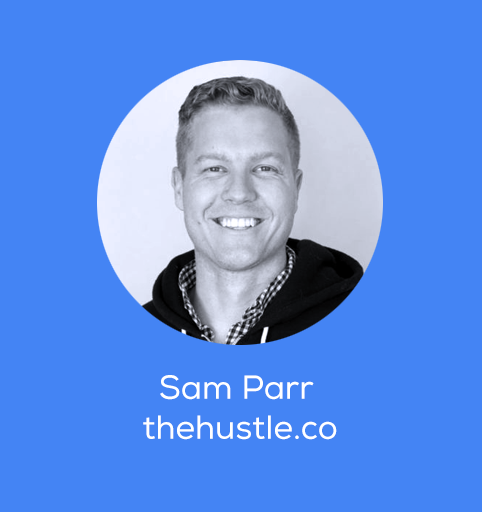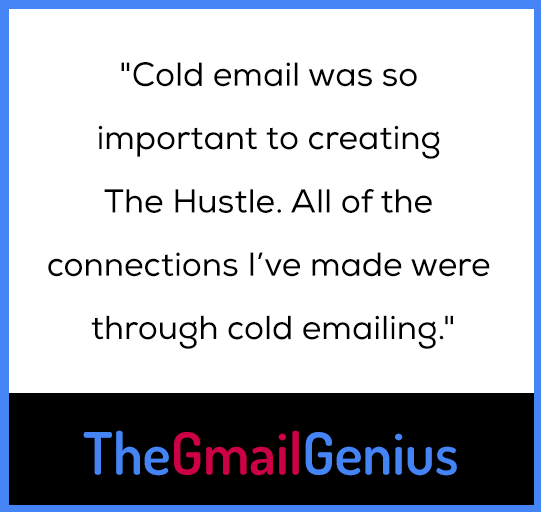How I Email: Sam Parr, Co-Founder and CEO, The Hustle
Email is a non-negotiable part of everyday life. For some, it’s an unruly time suck, but enlightened email users have systems to ensure they’re not a slave to the inbox. We’re asking smart thinkers to give us a peek inside their inboxes, share tips, ideas, gripes, and everything in between.
Sam Parr is the brains behind The Hustle, the daily tech and business new email. The company also hosts Hustle Con and other events throughout the year. The email maven shed light on his own inbox habits and preferences — apparently he’s a big J.Crew email fan.

What does your daily email routine look like?
I check email first thing in the morning, but usually don’t reply. I wake up around 7am, check email on the Apple Mail app on my phone, then swipe unread after reading them. I have my email open all day at the office, but I never reply to every email. I get 100-200 emails a day, so I’m very purposeful in selecting the few I reply to.
My process for responding to cold calls is a little different. I won’t reply to a cold email until the person has emailed me two or three times.
After 8pm, I try not to check emails again, but I often do. I won’t reply until the next day, though.
Are you an Inbox Zero person?
Absolutely. A clean inbox is always on my to do list. I have my Gmail set up so that all unread emails are stacked at the top then I make sure they go down to zero by the end of the day. Sometimes I accomplish that by reading through them and other times I just click “read.” I also generally don’t delete emails right away. I archive them instead.
What are some of your email pet peeves?
I have so many. My opinions are very polarized; I either absolutely love something or I completely hate it. One thing in the hate category right now is when people send an email but are unspecific about what they want you to do next. Things like, “Let’s chat sometime” or “I would love to pick your brain.” I hate that. Just tell me exactly what information you want and when you would like to talk. Every email should have a goal and I shouldn’t be confused about what your goal is.
Huge blocks of text in an email is another pet peeve. If I open your email and it’s one big paragraph of 10-20 sentences, that’s an immediate turn off. There’s no way I’m reading that, because it looks too intimidating.
I also hate when people send introduction emails without asking me ahead of time. Full inboxes are another one. If I see my girlfriend has 10,000 unread emails, it’s going to give me instant anxiety.
Do you use any email tools or browser extensions? Any favorites?
I used to use a ton. I used to love Boomerang and would use it to play jokes on people or to schedule an email to send at 2am, just to joke with them that I’m always grinding. I would only do it with friends. It was just silly.
I also used to use Email Hunter, which would show me who the people are that I’m emailing. I used to cold email often, and would have to guess email addresses, so this tool would tell me if their emails were right.
I was also a huge fan of Rapportive. I used it religiously for two or three years. Sidekick was another tool I used, especially when following up, that would show you when someone’s opening your mail.
Now I’ve decluttered, so I use very few plugins. I am on the lookout for a plugin that allows me to view my calendar in the email, because sometimes I won’t schedule things because the act of just looking at my calendar is a pain in the butt.
You shared some tips for emailing some pretty impressive people, like Jeff Bezos. Was cold emailing integral to building The Hustle?
Cold email was so important to creating The Hustle. All of the connections I’ve made were through cold emailing. There are so many people who I’m friends with or connected with now that I met this way. I would email them, they wouldn’t reply, and then I would change my approach and do it all over again. Sometimes it took 10 or 20 times before I received a reply and it required constant follow up.
I followed this process for years and it really paid off. Everyone is constantly amazed at the people I know, and it is all because of cold emailing and following up religiously. I would tell my coworkers “follow up or die” because we have to follow up and there’s a real art to being politely persistent.
What’s the secret when it comes to the art of the email follow up?
 Copywriting at its core is just using written words to get people to do what you want them to do. In order for that to happen, you have to understand what motivates people. So, my approach is different for everyone.
Copywriting at its core is just using written words to get people to do what you want them to do. In order for that to happen, you have to understand what motivates people. So, my approach is different for everyone.
Once, I was trying to get advice from Kevin Ryan, who started Business Insider. Kevin’s an internet legend and I know he’s inundated with emails. When I started talking to him I was hoping he would like seeing that there was this young guy who was a little bit like him when he was younger seeking advice. I would email him asking for feedback and advice, but he would never respond.
So, I changed my approach and started sending him updates like, “Hey, last time we talked our numbers were this, here’s what they are now. If you’re available, I’d love to get your advice on this specific thing.” I continued doing that and this guy eventually gave me a shot.
I used this technique with people all the time. If I wanted someone to speak at a conference, I would email and position my copy in a way that showed them if they came and spoke, they would accomplish this job or task. Even if they didn’t respond, I would follow up the following year and say something like, “The last time we talked there was going to be 300 people at this event and now there’s going to be 1,000. Here’s why you need to come.”
I would follow up constantly, but always make it about the other person. Always be politely persistent.
What makes an email newsletter successful?
You have to approach email as its own medium. And it really is a medium. Before I started The Hustle, people would often tell me email was dead and that Millennials don’t use email. People saying that are just wrong, though. It’s like saying Millennials don’t use the internet or go to websites. It’s the dumbest thing I’ve heard.
Anyone who has a job today has an email address. Anyone who’s in college has email. Email is the internet. The first thing I do every morning is check my email. We approached it as, when you’re looking at your phone, you’re looking at four inches of white space. With that in mind, does it actually matter whether you’re looking at a website or an email? Either medium is just real estate on a screen that gets a whole lot of attention.
The real question is, how do you tell stories that fit inside those constraints? What’s the goal? It can be quite challenging, but the one copywriting technique that always stuck with me is: you should remember the goal of one sentence is to get you to read the next sentence. The goal of the second sentence is to get you to read the third sentence. And so on.
If you have that mentality, there are a bunch of tactics that stem from that strategy. Keep sentences relatively short (under 25 words). Keep paragraphs short so the screen doesn’t look like a big block of text. Tactics like these.
Which email newsletters do you read?
I read a ton. I love what Axios is doing. I have a ton of New York Times newsletter subscriptions. I also subscribe to Indie Hackers, since we’re a bootstrapped company. I also love that they tell me what I need to know in the newsletter, instead of getting me to click off to their website.
I’m also a big fan of Quora. I read their daily emails all the time. Of course, I also read The Hustle. I even like reading newsletters from stores I love, like J. Crew, because they always have 50% coupons and other incentives.